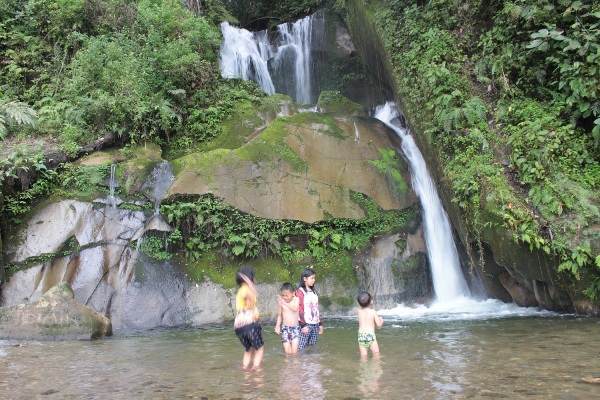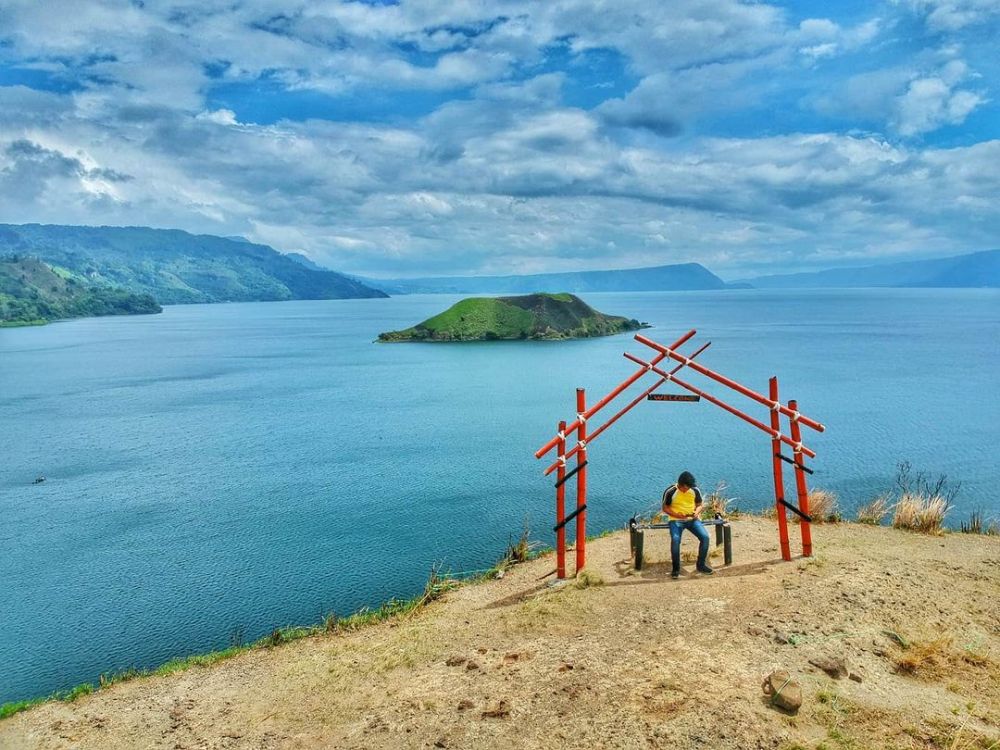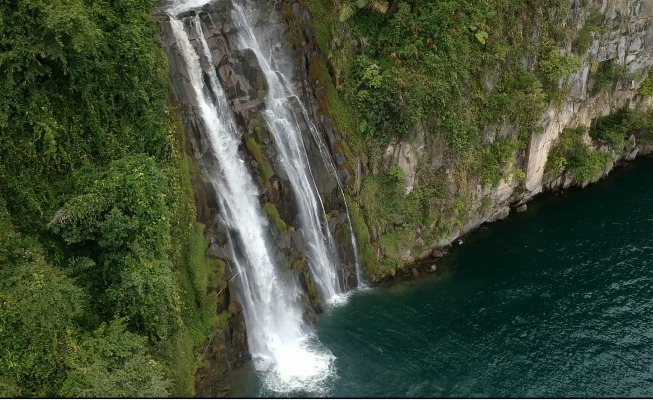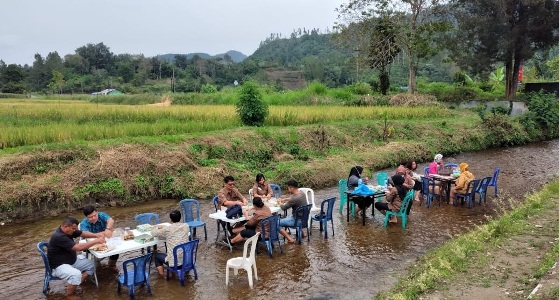NINNA.ID —Pernahkah kamu merasa ada suara magis dari Danau Toba yang memanggilmu untuk singgah lebih lama? Di Parapat dan Ajibata, dua kota kecil yang nyaris menyatu tapi tetap punya jiwa masing-masing, kamu akan menemukan lebih dari sekadar pemandangan indah. Keduanya adalah gerbang menuju petualangan, budaya, dan kenangan yang tak mudah terlupakan.
Meski hanya dipisahkan oleh ruas jalan, Parapat yang berada di Kabupaten Simalungun dan Ajibata di Kabupaten Toba menyimpan kekayaan destinasi yang berlimpah.
Parapat menawarkan deretan hotel dari yang sederhana hingga mewah, berdiri anggun di tepi Danau Toba dan puncak bukit, dengan panorama yang siap memanjakan mata dan hati.
Sedangkan Ajibata dengan sentuhan alamnya yang asri dan destinasi baru yang terus bermunculan, memberikan nuansa petualangan yang berbeda tapi sama-sama memikat.
Berikut ini 20 destinasi berjarak sekitar 15-20 km dari Kota Parapat atau Ajibata yang wajib kamu kunjungi. Destinasi ini siap membuat liburanmu bukan sekadar perjalanan, tapi pengalaman penuh cerita.
- Kampung Warna-Warni Parapat
Melewati kampung ini seperti masuk ke lukisan hidup, dengan rumah-rumah bercat warna cerah yang memancarkan keceriaan dan kebersamaan warga. Tempat ini bukan cuma Instagramable, tapi juga wadah kebanggaan lokal yang sudah menembus 50 besar Anugerah Desa Wisata Indonesia.
[caption id="attachment_497" align="alignnone" width="720"]
- Pasanggrahan Presiden Soekarno
Jejak sejarah mengalir di bangunan anggun ini. Di tepi Danau Toba, tempat ini menyimpan kisah masa pengasingan Bung Karno, membuat setiap sudutnya terasa penuh makna dan aura perjuangan yang menyentuh jiwa.
[caption id="attachment_28850" align="alignnone" width="1920"]
- Bukit Senyum
Namanya sudah membawa kebahagiaan. Dari sini, Danau Toba dan Pulau Samosir tersaji dalam panorama menawan, tempat sempurna untuk healing dan selfie sambil menikmati udara segar.
[caption id="attachment_35759" align="alignnone" width="1000"]
- The Kaldera Nomadic Escape
Spot foto kekinian dengan Jokowi’s Point yang legendaris. Nikmati pengalaman glamping dengan latar Danau Toba yang memesona—tempat di mana alam dan kenyamanan berpadu.
[caption id="attachment_32534" align="alignnone" width="1268"] Beberapa jenis wisata yang direkomendasi kepada peserta PON XXI antara lain: menjelajahi keindahan destinasi wisata yang ada di Kawasan Danau Toba seperti: Kaldera di Sibisa (foto: BPODT)[/caption]
Beberapa jenis wisata yang direkomendasi kepada peserta PON XXI antara lain: menjelajahi keindahan destinasi wisata yang ada di Kawasan Danau Toba seperti: Kaldera di Sibisa (foto: BPODT)[/caption]- Taman Eden 100
Dari hutan lebat, air terjun memukau, hingga jalur trekking seru, tempat ini adalah surganya pencinta alam. Belajar sekaligus menyatu dengan Geopark Kaldera Toba di sini sangat menyegarkan.
[caption id="attachment_3918" align="alignnone" width="600"] Air Terjun Tongguran di Taman Eden.(foto:asmon)[/caption]
Air Terjun Tongguran di Taman Eden.(foto:asmon)[/caption]- Kampung Girsang
Tak jauh dari Parapat, Kampung Girsang menanti dengan segala kehangatan budaya Batak. Rumah adat tua, panorama sawah terasering, dan spot-spot memukau seperti Bukit Sirikki, Bukit Simumbang—semuanya memanjakan mata.
Budaya gotong royong tetap hidup di sini, menjadikan Girsang lebih dari sekadar destinasi wisata. Ini adalah pengalaman autentik yang membuatmu merasa seperti pulang ke rumah.
[caption id="attachment_35461" align="alignnone" width="2000"]
- Taman Kera Sibaganding
Wahana seru untuk keluarga dengan penghuni primata lucu seperti si Siamang. Kamu bisa berinteraksi langsung dan belajar dari pawangnya yang ramah.
[caption id="attachment_26644" align="alignnone" width="2560"] Para peserta Fam Trip Simalungun bercengkerama dengan Nelly (foto: Damayanti)[/caption]
Para peserta Fam Trip Simalungun bercengkerama dengan Nelly (foto: Damayanti)[/caption]- Pantai Bebas
Pantai bebas merupakan ruang terbuka publik yang disiapkan pemerintah agar masyarakat dapat menikmati fasilitas yang ada.
Pantai bebas direnovasi pada 2019 dan diresmikan oleh Jokowi pada Februari 2022.
[caption id="attachment_5062" align="alignnone" width="600"] Areal parkir dan taman Pantai Bebas Kota Parapat.(foto:damayanti)[/caption]
Areal parkir dan taman Pantai Bebas Kota Parapat.(foto:damayanti)[/caption]Di pantai bebas ini, plang “I love Danau Toba-Simalungun” yang sudah ada sebelumnya, diubah menjadi lebih menarik. Tulisan dengan huruf kapital dicat warna silver.
Ada juga tangga khusus yang hanya dapat dilalui maksimal 6 orang. Dari tangga ini kita dapat berfoto selfie dengan latar belakang pemandangan Danau Toba.
Ada taman-taman yang berisi bunga-bunga ditata dengan rapi. Bagi anak muda yang suka olah raga ekstrim, telah disediakan area skateboard.
Ada wahana bermain, sejumlah bangku, toilet, dan pondok untuk berisitirahat. Lintasan menuju areal parkir juga sangat mulus.
- River Side Juma Bulu Sijambur
Destinasi baru dengan panorama sawah dan sungai jernih, sempurna untuk slow travel, yoga, dan photoshoot. Suasana tenang yang membuat siapa saja betah.
[caption id="attachment_35580" align="alignnone" width="2048"]
- Bukit Pass Desa Bangun Dolok
Camping dan sunrise di sini jadi pengalaman luar biasa. Dari puncak bukit, satu pertiga Danau Toba terbentang luas, bikin momen pagi makin magis.
[caption id="attachment_35762" align="alignnone" width="1280"]
- Replika Ikan Mas di Sipolha
Gerbang masuk berbentuk mulut ikan raksasa mengajakmu masuk ke dunia legenda Danau Toba. Eduwisata menarik yang menggabungkan mitos dan pemandangan.
[caption id="attachment_32023" align="alignnone" width="1280"] Replika Ikan Mas di Desa Sipolha kini terlihat lebih menarik setelah direnovasi (foto: Damayanti)[/caption]
Replika Ikan Mas di Desa Sipolha kini terlihat lebih menarik setelah direnovasi (foto: Damayanti)[/caption]- Pusat Informasi Geopark Nasional Kaldera Toba
Pusat edukasi geologi, hayati, dan budaya yang membuka mata tentang keunikan Kaldera Toba. Tempat wajib singgah untuk menambah wawasan wisatawan.
[caption id="attachment_35760" align="alignnone" width="1024"] Pusat Informasi Geopark Nasional Kaldera Toba di kompleks panggung terbuka, Parapat, Simalungun. (foto: istimewa)[/caption]
Pusat Informasi Geopark Nasional Kaldera Toba di kompleks panggung terbuka, Parapat, Simalungun. (foto: istimewa)[/caption]- Batu Gantung
Simbol janji dan kesetiaan dari kisah tragis Seruni, Batu Gantung membawa nuansa emosional dan budaya Batak yang dalam, sekaligus menjadi spot refleksi jiwa.
[caption id="attachment_4700" align="alignnone" width="600"] Objek Batu Gantung terlihat menggantung di tebing jurang.(foto"asmon)[/caption]
Objek Batu Gantung terlihat menggantung di tebing jurang.(foto"asmon)[/caption]- Air Terjun Bukit Gibeon
Kolam renang alami dengan air pegunungan yang dingin menyegarkan. Suasana alam Kaldera Toba bikin pengunjung betah berlama-lama.
[caption id="attachment_2681" align="alignnone" width="601"] Air terjun menjadi sumber air ke kolam di Pemandian Bukit Gibeon.(Foto:asmon)[/caption]
Air terjun menjadi sumber air ke kolam di Pemandian Bukit Gibeon.(Foto:asmon)[/caption]- Bukit Sipolha dan Pulau Hole
Spot trekking dengan pemandangan Danau Toba dan pulau mungil di tengah danau. Tempat ini mengajarkan kita menjaga alam sembari menikmati keindahannya.
[caption id="attachment_3456" align="alignnone" width="1000"] Bukit Sipolha.(Foto:ist)[/caption]
Bukit Sipolha.(Foto:ist)[/caption]- Air Terjun Situmurun
Air terjun magis yang langsung mengalir ke Danau Toba, menawarkan kesegaran dan pemandangan dramatis yang sulit dilupakan.
[caption id="attachment_2452" align="alignnone" width="653"] Air Terjun Situmurun di Desa Hatinggian Kecamatan Lumbanjulu Kabupaten Toba, dari tangkapan drone.(Foto:drone)[/caption]
Air Terjun Situmurun di Desa Hatinggian Kecamatan Lumbanjulu Kabupaten Toba, dari tangkapan drone.(Foto:drone)[/caption]17. Ekowisata KHDTK Aek Nauli,di Simalungun
Inilah destinasi wisata alam yang bukan hanya memanjakan mata, tetapi juga mengajarkan kita pentingnya menjaga kelestarian lingkungan.
Di sini, kamu bisa bertemu rusa, bermain bersama gajah di hari tertentu, atau sekadar menikmati udara segar di camping ground. Ada rute pendakian yang menantang dan pondok-pondok istirahat untuk melepas lelah.
Taman rusa dan konservasi gajah di KHDTK Aek Nauli begitu memikat, mudah ditemukan di pinggir Jalan Raya Parapat Sibaganding, sebelum melewati Panatapan Parapat. Di sisi kiri jalan (jika datang dari Medan) terpampang tulisan Aek Nauli Elephant Conservation Camp (ANECC), sementara di sisi kanan ada tulisan KHDTK Aek Nauli.
[caption id="attachment_5316" align="alignnone" width="2560"] Sisi kanan Kawasan Hutan Dengan Tujuan Khusus Aek Nauli jika datang dari Pematangsiantar.(foto:damayanti)[/caption]
Sisi kanan Kawasan Hutan Dengan Tujuan Khusus Aek Nauli jika datang dari Pematangsiantar.(foto:damayanti)[/caption]Setiap sudut di Aek Nauli menyimpan keindahan alami yang wajib dijaga. Jangan lupa, jika ingin melihat gajah atau berkemah, pastikan kamu mengurus izin dan retribusi yang telah ditentukan.
Jadi, sebelum kamu mengagumi keindahan Danau Toba, sempatkan dulu bertualang di KHDTK Aek Nauli. Yuk, nikmati pesona alamnya dan jangan lupa jaga kebersihan agar keindahannya tetap lestari hingga generasi mendatang!
18. Binanga Cafe
Binanga Cafe di Toba menghadirkan pengalaman unik menikmati kuliner di tengah aliran sungai, tanpa dekorasi modern seperti plafon, bar, atau lukisan abstrak. Lantainya berupa batu alam pipih yang nyaman dipijak karena bebas lumut. Terletak di Lumbanrang, Desa Sionggang Utara, Kecamatan Lumbanjulu, Kabupaten Toba, cafe ini dapat ditemukan saat melintasi jembatan Lumbanrang, sekitar 300 meter dari Simpang Taman Eden 100.
Dikelola oleh Marandus Sirait dan Ranap Manurung, Binanga Cafe dibuka pada 5 Juni 2021. Menu andalannya adalah beragam olahan ikan khas Batak seperti arsik, ikan bakar, naniura, hingga ikan jumbo seberat 5 kg. Tersedia juga madu asli dengan honeycomb. Sensasi bersantap di sungai, sambil menikmati ikan yang berenang dan kaki yang digelitik air, menambah pengalaman tak terlupakan.
[caption id="attachment_1423" align="alignnone" width="559"] Binanga Cafe di Lumbanrang, Desa Sionggang Utara, Kecamatan Lumbanjulu, Kabupaten Toba.(Foto:istimewa)[/caption]
Binanga Cafe di Lumbanrang, Desa Sionggang Utara, Kecamatan Lumbanjulu, Kabupaten Toba.(Foto:istimewa)[/caption]Setelah makan, pengunjung bisa bersantai di hammock sambil menikmati suasana alam yang asri. Bagi wisatawan yang mengunjungi Kaldera Toba, Binanga Cafe menjadi destinasi wajib, dengan tetap mematuhi protokol kesehatan selama pandemi.
19.Batu Lihi Star Simalungun
Menjelajahi jalur sejuta pesona Parapat – Medan via Simarjarunjung dan Saribu Dolok selalu membuat traveler sulit beranjak cepat, karena pemandangan alamnya yang memikat. Salah satu magnet utama di sepanjang jalur ini adalah Batu Lihi Star, destinasi yang menawarkan panorama Danau Toba, Pulau Samosir, dan Bukit Senyum dari ketinggian.
Tepat di Batu Lihi Star, pengunjung bisa menyaksikan hamparan keramba jaring apung yang tampak seperti cincin raksasa di danau, spot selfie dengan menara khusus, serta tempat ikonik bernama Tikungan Mesra. Konon, jika pasangan berfoto di Tikungan Mesra, hubungan mereka akan langgeng hingga kakek-nenek. Syaratnya, pria harus mengenakan topi ulos, dan wanita memakai sortali ulos yang disediakan gratis.
[caption id="attachment_6529" align="alignnone" width="667"] Salah satu spot foto di Batu Lihi Simalungun.(foto:asmon)[/caption]
Salah satu spot foto di Batu Lihi Simalungun.(foto:asmon)[/caption]Selain panorama menawan, Batu Lihi Star juga dilengkapi fasilitas lengkap seperti minimarket, penginapan, kuliner, serta bebas biaya parkir. Lokasinya di Pematang Tambun Raya, Simalungun, hanya sekitar 30 menit dari Parapat atau Pematangsiantar.
Jangan lupa, di Batu Lihi Star, pesona alam berpadu dengan legenda romantis—tempat ini layak menjadi persinggahan wajib di jalur sejuta pesona.
20. Beragam Pantai Pasir
Dahulu, hampir seluruh tepi Danau Toba berupa pantai pasir putih yang berfungsi untuk kebutuhan sehari-hari masyarakat. Seiring waktu, banyak pantai di kawasan tersebut dibangun menjadi hotel dan tempat wisata pantai pasir.
[caption id="attachment_5457" align="alignnone" width="600"] Para pengunjung Pantai Wisata Bahari bermain di pantai.(foto:damayanti)[/caption]
Para pengunjung Pantai Wisata Bahari bermain di pantai.(foto:damayanti)[/caption]Di Parapat dan Ajibata sekitarnya ada banyak hotel terintegrasi dengan pantai. Misalnya Pantai Wisata Bahari. Ada juga pantai yang dikelola oleh masyarakat.
Kenapa Kamu Harus Eksplor Parapat Ajibata Sekarang?
Karena Parapat dan Ajibata bukan hanya gerbang menuju Pulau Samosir. Mereka adalah destinasi penuh warna, sejarah, budaya, dan keindahan alam yang siap membawamu pulang dengan cerita dan kenangan indah.
Penulis/Editor: Damayanti Sinaga









































































































